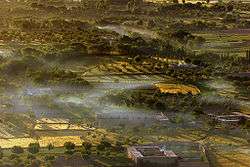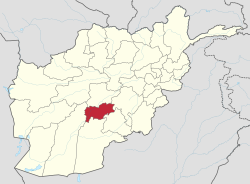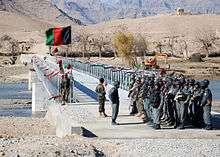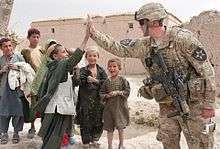Uruzgan Province
Uruzgan (Pashto: اروزګان; Persian: اروزگان), also spelled as Urozgan or Oruzgan, is one of the thirty-four provinces of Afghanistan. Uruzgan is located in the center of the country. The population is 333,500, and the province is mostly a tribal society.[1] Tarinkot serves as the capital of the province.
Uruzgan اروزگان | |
|---|---|
 Aerial photo of fields somewhere in Uruzgan Province | |
 Map of Afghanistan with Uruzgan highlighted | |
| Coordinates (Capital): 32.8°N 66.0°E | |
| Country | |
| Capital | Tarinkot |
| Government | |
| • Governor | Mohammad Nazir Kharoti |
| Area | |
| • Total | 12,640 km2 (4,880 sq mi) |
| Population (2012)[1] | |
| • Total | 333,500 |
| Time zone | UTC+4:30 (Afghanistan Time) |
| ISO 3166 code | AF-URU |
| Main languages | Pashto and Persian |
In 2004, the new Daykundi province was carved out of an area in the north, leaving Uruzgan with a majority Pashtun population and Daykundi with a majority of Hazaras (see map in infobox for the provincial boundaries that resulted). In 2006, however, Gizab District was taken back from Daykundi and re-annexed to Uruzgan, becoming the province's sixth district. Today Uruzgan borders the provinces of Kandahar, Daykundi, Ghazni, Zabul and Helmand.
Geography
Uruzgan province is located in the southern Afghanistan, bordering Zabul and Kandahar to the south, Helmand to the southwest, Daykundi to the north, and Ghazni to the east. Uruzgan covers an area of 12,640 square kilometres (1,264,000 ha). Much of the province is mountainous or semi-mountainous terrain, while the rest of the area is made up of flat land.[2]
History
The region was part of ancient Arachosia, and was ruled by the Medes before it fell to the Achaemenids. In 330 BC, Alexander the Great occupied the area but left it to Seleucids to rule. It was later attained and ruled by the Mauryas under Ashoka. By the 7th century, when the Arabs first arrived, it was under the control of the Zunbils before being conquered in the name of Islam by the Saffarids in the 9th century. It fell to the Ghaznavids followed by the Ghurids before the Mongol invasion in the 13th century. The area was ruled by Arghun Khan of Ilkhanate, later by the Timurids, Mughals and Saffavids.
In 1709, the Hotak dynasty rose to power in Kandahar and defeated the Safavids. Then, he took control of entire southern Afghanistan while most of the Durrani Pashtuns were settled in the Herat area at the time. In 1747, one of Nader Shah's commanders, Ahmad Shah Durrani, became leader of the Afghans and the region of Uruzgan was one of the first to become part of his new Durrani Empire, which became to what is now the modern state of Afghanistan.
During the 1980s Soviet war in Afghanistan, Uruzgan witnessed fighting between pro-Soviet forces and the Mujahideen. One of the most prominent local Mujahideen leaders was Jan Mohammad Khan. In late 1994, Uruzgan was captured by the Taliban. They were toppled by US-led forces in late 2001. Hamid Karzai and his followers arrived to Uruzgan between October and November 2001 to take over control of the area.
Recent history

In June 2002 a wedding party in Uruzgan was mistakenly bombed by the U.S. Air Force, which resulted in the death of 30 civilians.[3] In the wake of the fall of the Taliban — from January 2002 through March 2006 — the province was governed by Jan Mohammad Khan, a warlord ally of Afghan President Karzai, and a member of the same Popalzai Pashtun tribe. In March 2006 Karzai appointed Maulavi Abdul Hakim Munib, a former Taliban official who had reconciled with the Government of Afghanistan, to replace Jan Mohammad Khan.
In the summer of 2006 insurgents in Uruzgan were targeted by a NATO-Afghan military offensive called Operation Mountain Thrust. In September 2007 President Karzai removed Munib, who had become increasingly ineffective.
In August 2006, the NATO-led International Security Assistance Force (ISAF) assumed authority for Uruzgan from the US-led coalition, as the Netherlands took command of the Provincial Reconstruction Team (PRT) from the US as Task Force Uruzgan. There is also an Australian element under the Dutch command.

Because of security concerns and the Taliban insurgency, only one international aid agency (GIZ) has a permanent presence in Uruzgan. NATO's ISAF operates a PRT in Tarinkot. The 1,400 Dutch and 1,090 Australian troops in the area secured only the largest population centres in Uruzgan (Deh Rawood, Chora, and Tarinkot towns) under the Dutch "inkspot policy". However, the force's area of responsibility included the entire province. Gizab district, Uruzgan's most dangerous, had no ISAF presence before. In August 2010, the 1,950 Dutch forces withdrew their forces from Uruzgan province, after a political disagreement in the Dutch parliament, leaving the PRT to the US and Australia to continue the mission.
_with_the_56th_Infantry_Brigade_Combat_Team%2C_Texas_Army_National_Guard%2C_watches_Afghans_pass_during_a_logistics_130604-A-FS372-018.jpg)
Uruzgan's opium poppy crop reached record levels in 2006 and 2007, according to the United Nations Office on Drugs and Crime (UNODC), as no significant eradication efforts were carried out by the Afghan administration or Dutch forces.
From 15 to 19 June 2007 Dutch, American, Australian and Afghan soldiers defended the town of Chora against an assault by Taliban combatants. Reports in the Dutch, Australian[4] and US press[5][6][7] indicated that the battle was one of the largest Taliban offensives of the year. The fighting resulted in the deaths of a Dutch soldier, 1 Australian soldier, 1 American soldier, 16 Afghan policemen, an unknown number of civilians and a large number of Taliban.
In September 2008 Rozi Khan, the leader of Uruzgan's Pashtun Barakzai tribe, and a longtime rival of Popalzai leader Jan Mohammed Khan, was killed in a firefight in Chora District.
Gizab District was temporarily cleared of the Taliban by ISAF forces in late April 2010 and attributed to help from the uprising of the townspeople.[8][9]
In February 2010, near Khod, over ten civilians in a three-vehicle convoy were killed by a combined force of a Lockheed AC-130, Bell OH-58 Kiowa helicopters and General Atomics MQ-1 Predator drones, who misidentified them as Taliban. The air forces were attempting to protect ground troops fighting several km away.[10][11]
Politics and governance
The current governor of the province is Mohammad Nazir Kharoti. The city of Tarinkot is the capital of the province. All law enforcement activities throughout the province are controlled by the Afghan National Police (ANP). The provincial police chief represents the Ministry of the Interior in Kabul. The ANP is backed by other Afghan National Security Forces (ANSF), including the National Directorate of Security (NDS) and NATO-led forces.
Transportation
As of May 2014 the province was served by Tarinkot Airport which had regularly scheduled direct passenger service to Kabul.
Healthcare
The percentage of households with clean drinking water increased from 8% in 2005 to 27% in 2011.[12] The percentage of births attended to by a skilled birth attendant increased from 6% in 2005 to 14% in 2011.[12]
Education
The overall literacy rate (6+ years of age) increased from 5% in 2005 to 17% in 2011.[12] The overall net enrollment rate (6–13 years of age) increased from 1% in 2005 to 49% in 2011.[12]
Demographics


The population of Uruzgan is reported to be around 333,500.[1] The province has an estimated 45,000 households, each with about six members on average. The large portion of Uruzgan's settled population belong to ethnic Pashtuns and ethnic Hazaras.[13] There is also a small population of Kuchi nomads, whose numbers vary with the seasons.[13]
Population figures are from the Ministry of Rural Rehabilitation and Development, the Central Statistics Office Afghanistan, and the Liaison Office study 2009.[14]
Districts
| District | Capital. | Population[15] | Area[16] | Notes |
|---|---|---|---|---|
| Shahidi Hassas | 86,100 | |||
| Chora | 98,750 | |||
| Deh Rawood | Deh Rawood | 99,718 | ||
| Khas Uruzgan | 96,888 | |||
| Tarinkot | Tarinkot | 110,476 |
See also
References
| Wikimedia Commons has media related to Urozgan Province. |
- "Settled Population of Urozgan province by Civil Division, Urban, Rural and Sex-2012-13" (PDF). Islamic Republic of Afghanistan, Central Statistics Organization. Retrieved 2018-07-19.
- "iMMAP_Uruzgan_Admin_/Lands_A0_20110125" (PDF). Uruzgan Province January 2011. Retrieved 2016-01-05.
- "'Scores killed' in US Afghan raid". BBC News. 2002-07-01. Retrieved 2018-07-19.
- "Aussie troops backed Dutch against Taliban". news.com.au. 2007-06-23. Archived from the original on 2007-06-26. Retrieved 2008-03-25.
- "Over 100 die in southern Afghan battle". USA Today. 2007-06-18. Retrieved 2018-07-19.
- "Dutch military chief says Taliban executed civilians during fighting with NATO forces". International Herald Tribune. 2007-06-22. Archived from the original on 2007-06-27. Retrieved 2008-03-25.
- "Over 100 Militants, Civilians and Police Killed In Massive Afghan Battle". Fox News. Associated Press. 2007-06-18. Retrieved 2018-07-19.
- "Aussies help reclaim Afghan town". SMH. AAP. 2010-04-29. Retrieved 2018-07-19.
- "From gunfire to governance in Gizab". ADF. 2010-04-29. Retrieved 2018-07-19.
- David S. Cloud (2011-04-10). "Anatomy of an Afghan war tragedy". Los Angeles Times. Retrieved 2018-07-19.
- Karin Brulliard (2010-05-30). "Drone operators blamed in airstrike that killed Afghan civilians in February". The Washington Post. Retrieved 2018-07-19.
- Archive, Civil Military Fusion Centre
- "Uruzgan Province" (PDF). Program for Conflict and Culture Studies. Naval Postgraduate School (NPS). Archived from the original (PDF) on 2013-10-29. Retrieved 2013-10-25.
- The Liaison Office, Three Years Later: A Sociopolitical Study of Uruzgun Province from 2006 to 2009
- "Urozgan Province". United Nations. Afghanistan's Ministry of Rural Rehabilitation and Development. 2006–2007. Archived from the original on 2013-04-14. Retrieved 2012-07-18.
- Afghanistan Geographic & Thematic Layers Retrieved 2018-07-19.